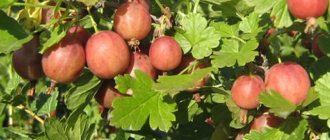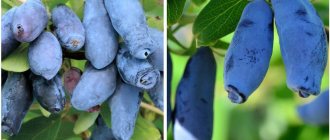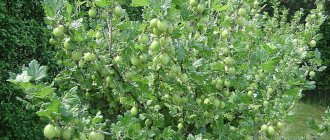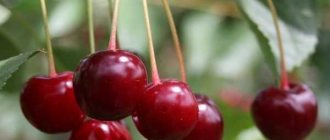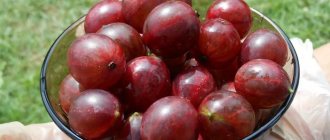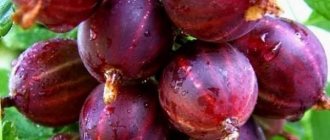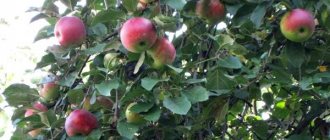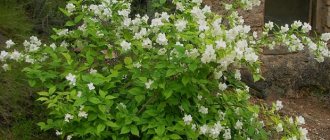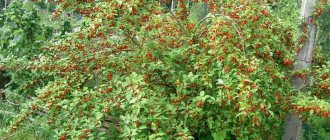Description of the bush and berries
Amber gooseberry is a tall shrub, reaching one and a half meters in height, its branches are dense and spreading, requiring garters on supports or trellises.
Gooseberries are amber (orange-yellow) in color, oval in shape, slightly thickened at one end, the largest and juiciest are distinguished by an excellent sweetish taste with a hint of acid and honey aroma, their average weight is 5.0 g.
Advantages and disadvantages
| Advantages of the variety | Disadvantages of the variety |
|
|
Description of the gooseberry variety Amber
Before choosing a variety for planting, gardeners try to familiarize themselves with its characteristics and requirements. The originators have compiled a detailed description of the Amber gooseberry so that growing the crop does not cause problems.
The bushes of the plant are quite tall. In adulthood they reach from 1.5 to 1.8 m.
The branches are spreading and long, with weak foliage. Due to their length, they require tying or supports. There are very few thorns on the shoots, but they are sharp and require caution when working with the bush.
There are few leaves on the branches. They are medium in size and bright green in color.
The fruits are yellow-orange in color, which served as the choice for the name of the gooseberry variety.
The color of the berries is rich and very beautiful. The taste is sweet, with a slight sourness. A distinctive feature of Yantarny fruits is their honey aroma. The pulp is quite dense, but juicy. One berry weighs about 5 g, has an oval shape and light veins on the skin.
Attention! The characteristics of the variety allow it to be successfully grown throughout almost the entire territory of Russia, Belarus and Ukraine.
Characteristics
| Main characteristics of the variety | Indicators |
| Plant height | Up to 1.5 m |
| Average weight of berries | Up to 5.5 g |
| Ripening time | Early and middle |
| Attitude to diseases | Resistant variety, powdery mildew affects it extremely rarely |
| Average harvest per season | 7-8 kg |
| Record harvest | 10.5 kg |
| Relation to low temperatures | Frost-resistant |
Productivity
The quality and quantity of the Amber gooseberry harvest increases when all agricultural growing technologies are followed: when planting and regular pruning, when choosing a location and careful care, when taking timely measures to combat diseases and harmful insects.
Drought resistance and winter hardiness
The gooseberry variety Amber is unpretentious and resistant to periods when there is not enough moisture, the plant tolerates winter frosts well, even in cold weather of -40° the root system is preserved, only branches not sufficiently covered with snow can freeze slightly. Such branches are removed during spring sanitary pruning.
Resistance to diseases and pests
The Yantarny gooseberry variety has a natural immunity to many fungal diseases; over many years of testing, it has shown itself to be the best in terms of resistance to the invasion of harmful insects. According to the observations of gardeners, plants rarely get sick and are not very often attacked by pests such as gooseberry aphids.
Maturation period
The ripening of gooseberries depends on the geographical location of the region in which this variety is grown. The warmer the climate, the earlier the berries of the Yantarny gooseberry variety gain fruit maturity. In the south of Russia this may be the beginning of June, and in the west and east - mid-July to the end of August. In the northern regions of the country - from July to September, it depends on favorable or not very favorable weather conditions, because the weather is not always the same from year to year.
Transportability
Agro-industrial companies selling gooseberry fruits of the Yantarny variety harvest the berries 7-10 days before they are completely ripened; the gooseberry skin at this time is still quite dense and strong, so it does not crack or burst during transportation.
Harvesting and storage
There are 2 degrees of gooseberry ripeness - technical and consumer. Technical ripening of the berry occurs 10 days before complete ripening. At this time, the berry begins to acquire the characteristic amber color, but still remains quite dense and sour. Such berries are suitable for long-term storage, transportation and processing. Fully ripe fruits are collected for immediate consumption or for making jam, jam, when the berries need to be well boiled.
The harvest period is different for each region; fruit picking begins in June and ends in September. The weather for picking berries should be dry and warm to maximize the shelf life of the crop.
You need to pick the fruits with your hands, keeping the stalk intact. Berries should be stored in special fruit boxes, no more than 5 kg in each. When fully ripe, the crop can be stored in cold, ventilated rooms for about 4 days, at temperatures from 0°C to +5°C. Collected fruits in a state of technical maturity are stored for about 10–15 days.
Landing Features
Amber gooseberry seedlings can be planted at any time convenient for the gardener: early spring, mid-summer or on the eve of winter. According to many gardeners, planting seedlings in late autumn gives even more chances for rapid establishment of the plant and its successful development in the future.
The site for planting should be sunny, well fertilized and not exposed to drafts, the soil is preferably slightly acidic, neutral or slightly alkaline, the soil is fertile and loose. The best option is to plant gooseberries along a fence or wall of a house that faces south. Maintain a distance between seedlings of 1.5 meters; if plantings are in 2 or more rows, then there should be at least 2 meters between the rows
Warning! The thorns of Amber gooseberry bushes are short but very sharp. Protect your hands from scratches; when caring for the plant, wear gloves, preferably thick, rubberized ones.
Planting and caring for gooseberries
It is recommended to purchase seedlings of the Yantarny variety from nurseries when they are no older than 2 years old. In this case, it is necessary to select specimens with a well-developed root system and viable buds in sufficient quantities.
Planting can be done at a convenient time - spring, summer or autumn. Gooseberries, planted even before the onset of winter frosts, take root and develop well.
Important! Gardeners recommend autumn planting of Yantarny.
The place for Amber gooseberries is sunny, with good nutritious soil. It is important that the area is not exposed to drafts and that the soil is not acidic. The best option is to plant along a hedge, fence or wall on the south side.
If you decide to place the bushes in several rows, then leave 1.5 m between plants and 2 m between rows.
First, the site is dug up, removing debris and weeds, adding organic matter - compost or humus (30 kg per 1 sq. m). If there is no such quantity of fertilizers, then it is recommended to dig holes for the Yantarny variety in advance, mix the bottom layer of soil with humus (20 kg) and wood ash (1 cup). Leave for 2-3 days.
The Yantarny variety is planted without tilting. The roots are straightened, gradually covered with soil and watered with water. Then the earth is compacted to avoid voids, the plant is watered, and the circle around the trunk is mulched.
Cut the shoots to bud level 5.
Aftercare
The basic rules for caring for gooseberries are regularity, quality and lack of fanaticism. The plant is quite resistant to unfavorable factors, so it should only be helped in its development. With good care, the Amber gooseberry fully corresponds to the description and photo.
Main care points:
- Watering.
Most of all, gooseberries need moisture during the period of awakening and bud growth. For industrial cultivation, the ideal solution would be to install drip irrigation. During the season, the Yantarny variety is moistened as the soil dries out. One young bush needs 30 liters of water, an adult - 50 liters. Watering only at the root, sprinkling is not suitable for gooseberries. Important! You cannot use cold water from wells. - Loosening and weeding. Necessary for removing weeds and improving air access to the roots. The depth of loosening is no more than 15 cm. If the soil is mulched, the number of weedings per season will be significantly reduced.
- Feeding. Every year, for good development of gooseberry bushes, add 0.5 buckets of humus and 3-4 cups of wood ash. In spring, the plant needs nitrogen fertilizers, during flowering and budding - potassium and phosphorus. In the fall, the gooseberry bush is mulched with peat and sawdust, and with the arrival of spring, it is removed.
- Trimming. It is carried out after the leaves fall from the gooseberries. The first year, shoots of the Yantarny variety are cut into 6 buds. In the second and third years of life, they are shortened by 2/3 of the length. In the fifth year, the formation ends and regular sanitary pruning is carried out to remove dry, old, frozen and broken branches. In addition to pruning, gooseberries need supports or tying.
- Sheltering gooseberries for the winter. The event is necessary in regions with a risk of severe frosts and long snowless winters. The root zone of the Yantarny variety is sprinkled with peat, sawdust, and covered with non-woven material or film on top.
Additional measures include preventive treatments against diseases and pests.
Rules of care
Gooseberry seedlings of the Yantarny variety grow very quickly, gaining height and density, so you cannot do without certain measures to care for them.
Support
In the second or third year of life, special supports are built around the seedlings and, if necessary, gooseberry branches are tied to its parts.
Top dressing
In the first three years, Amber gooseberries do not require additional fertilizer if a sufficient amount of organic matter and mineral fertilizers were provided during planting. Subsequently, fertilizing is carried out no more than 3 times throughout the season; organic fertilizers are applied only in early spring.
Bush pruning
Pruning is a necessary and regular process when growing gooseberries. It is produced annually, mainly in spring or after harvest.
Reproduction
Gooseberries can be propagated in two ways: layering and rooting cuttings of the current year. To obtain a large number of seedlings, the second method is more acceptable.
Preparing for winter
After harvesting, gooseberry bushes are sprayed with Bordeaux mixture. Then the soil around the bushes is dug up, combined with fertilizing, and sanitary pruning is performed. If weather forecasters promise a cold winter and long, persistent frosts, then additional insulation is used - dense agrospan.
Growing technology
To obtain a large gooseberry harvest, compliance with growing technology is required. Deviation from the rules is guaranteed to reduce the number of berries and reduce the speed of development of the bush.
Optimal conditions
2 weeks before planting, prepare the area. It is dug up to a depth of 25-30 cm. Until planting, the soil is left in a loose state, removing sprouted weeds. Then the surface is leveled to ensure high-quality watering in the future.
Landing dates and rules
Seedlings are planted at any convenient time, except winter. Many believe that the most suitable period is late autumn. This makes it more likely that the plant will take root.
The site for planting is selected to be sunny, fertilized, and protected from drafts. It is desirable that the soil be neutral, slightly alkaline or slightly acidic.
The distance between individual seedlings is maintained at 1.5 m, between rows - 2 m.
Further care
After planting, they move on to caring for the plants. The speed of development of the shrub depends on the correctness of various procedures. Care methods depend on the season and weather conditions.
In the spring, make sure there are no weeds. They also fertilize and regularly loosen the soil. In summer, intensive watering is added to these actions. In autumn, gooseberries are prepared in the winter. The bushes are trimmed and insulated.
Young bushes are regularly watered with warm water: 2 times a week, one bucket for each plant. Water is poured under the root. In rainy weather, the plants are not watered, as the crop does not like overly moist soil.
Gooseberries are fed annually. To do this, take 5 parts of humus and 1 part of ash. The mixture is scattered under the bush in a layer of 2-3 cm.
After harvesting, the soil is mulched with straw or sawdust. In the spring, this layer is removed, and the ground around the bushes is loosened.
In the first year after planting, formative pruning is carried out. It is required for the proper development of shrubs. In the second and third years, two-year-old shoots are cut off by half. In the fourth year, the gooseberries are thinned out. At the same time, dried and weak branches are removed.
Powerful and spreading bushes are supported. They drive stakes around the gooseberries and tie them with a tight rope. If the plant is planted near a fence, its branches are tied to a trellis.
Possible problems, diseases, pests
Most often, gooseberries are affected by powdery mildew. Its presence is determined by a white coating on the leaves. After a while it gets dark. Ovaries and fruits are affected.
With anthracnose, the leaves become covered with brown spots. To treat this disease, the plant is treated with Bordeaux mixture several times during the summer.
The mosaic appears as spots with a yellow tint. This disease cannot be treated, so the bush will have to be dug up and burned, and the area disinfected.
Among the pests on gooseberries are aphids, moths, and leaf beetles. To remove insects, the bush is treated with fungicides.
Wintering
When the harvest is harvested, the plant is treated with Bordeaux mixture. After this, the bushes are dug up, fertilized and pruned. Then a layer of fallen leaves is poured, and additional insulation is laid on top - dense agrospan.
Reproduction
Gooseberries are propagated in two ways: by cuttings and by planting layering.
In the first method, cuttings are prepared and cut from young shoots. The minimum length is 12 cm. The cuttings are cut in early May and immediately planted in a moist substrate. After this, they are watered regularly and protected from direct sunlight.
Planting layering is considered the most effective method of propagation. This procedure is carried out in mid-autumn, when sap flow stops. Low-lying cuttings are selected from the bush, bent to the ground and dug in. After germination they are replanted.
Features of cultivation depending on the region
The variety is known for its high viability. It has been grown in the middle zone for many years. In the northern regions, special attention is paid to the bushes - they must be fed before wintering. In southern climates, the shrub is regularly watered abundantly.
The ripening period of berries varies depending on the region. In the southern regions, the harvest is harvested in early July. In the western and eastern regions of Russia, this time shifts to the end of the month or the beginning of August. In the north, gooseberries ripen by September.
Pollinator varieties
Amber gooseberry was bred from the self-pollinating English variety, and therefore does not require additional pollinators on the site.
Pest and disease control
| Diseases | Signs | Treatment methods |
| Powdery mildew (spheroteka) | The appearance of a white coating on all parts of the plant, especially on young shoots and leaves. As the fungus spores multiply, they infect the ovaries and berries, and the coating gradually darkens and becomes denser | Pouring the bushes with boiling water in the spring (March-April), treating with special fungicides, using folk remedies |
| Anthracnose | White smooth spots appear on the gooseberry leaves; as they grow, they merge into much larger spots and turn brown | Treating bushes with Bordeaux mixture 4-5 times per season every 10-14 days |
| Septoria | The leaves become covered with small grayish spots with a dark border, curl and fall off. | Spray the bushes with a solution of Bordeaux mixture 2-3 times per season |
| Glass rust | Bright orange growths appear in the form of small glasses on the back of the gooseberry leaves. | Treat with a solution of Bordeaux mixture 3-4 times during the season |
| Gooseberry mosaic | Spots of a yellowish tint are located along the leaf veins, the leaf plates dry out, the plant stops growing | This viral disease cannot be cured; the affected bushes are dug up and disposed of, and the planting pit is completely disinfected |
Gooseberry pests
| Pests | How to fight |
| Gooseberry (currant) aphid | During bud break, spray with fungicides: Fitoverm, Kemifos, Iskra and others |
| Leaf Gnawer | Preventive treatment with fungicides during bud break |
| Sawers | Manual collection of caterpillars, spraying bushes 2-3 times with the same preparations |
| leaf roller | Apply identical products before the buds swell and after flowering |
| Ognevka | They use the same pesticides and spray them before and after flowering. |
| Padenitsa | Use fungicides and folk remedies |
Reproduction
Amber gooseberry belongs to varietal plants, but in everyday life the seed propagation method is not used as it is too troublesome. To obtain high-quality planting material, all types of vegetative propagation are used, which are simple and reliable, and fruiting will begin within 1 year after planting:
- Dividing the bush: with timely planting in the fall, fruiting occurs in the next season.
- Cuttings: A large number of cuttings can be grown from cuttings. The method requires regular monitoring: frequent watering, spraying, fertilizing.
- “Chinese” method: they dig in a gentle branch and in the spring they get a strong daughter plant - a cutting of the mother bush.
The last method is simple and accessible even to novice gardeners. From 1 bush you can safely grow 2-3 cuttings and for the next years your family will be provided with delicious berries and raw materials for winter preparations - compotes, jam, marshmallows and marmalade.
general information
This plant was obtained in the fifties of the last century by the Soviet breeder M.A. Pavlova. When creating Amber, the English yellow variety of berry was used. Within a few years after its creation, the variety spread throughout agricultural farms located in Ukraine, Belarus and Russia.
The bushes of the plant grow up to one and a half meters if you care for them properly. Greenish leaves appear on the branches of shrubs at the end of spring.
Also on the branches there are a small number of sharp thorns, which are colored light brown.
The variety is unpretentious to soil, and therefore it grows well in any conditions. The only place where Yantarny can bear fruit poorly is in swampy and oxidized soil with high humidity. It is better to grow the plant outside, as it is protected from frost.
Amber is classified as an early-ripening variety of gooseberry, which bears fruit in early summer. With proper care of grown shrubs, the yield reaches 10-15 kilograms per bush. Ripe fruits do not rot and can hang on plants for a long time. Ripe berries turn reddish after ripening, the weight of each of them reaches 5-7 grams.
Reviews
I have been growing “Amber” gooseberries for many years. The variety has been time-tested, produces very tasty fruits with a honey aroma, and does not fall off for a long time, which is also very important, because I only appear in the garden on weekends. I did not observe any diseases or pests. For prevention, I spray the bushes and soil with hot water in the spring, and also use Bordeaux mixture. No special drugs were ever used. As for fertilizing, in the spring I water it with a solution of chicken manure (1:20), in the summer and autumn I give mineral fertilizers that do not contain nitrogen. That’s basically all my work on this culture.
The “Amber” variety is very interesting in terms of yield and taste of berries, but I am not at all happy with its thorns. Now there are many varieties of blackberries and gooseberries that are completely without thorns, so breeders have something to strive for and maybe they will release a new modification of this variety, because according to other criteria it is very good.
Amber gooseberry has been pleasing gardeners with its delicious, aromatic berries for more than half a century. Try planting this variety in your garden. After all, the best is the enemy of the good, and in the constant pursuit of something new, we can miss that precious amber that has long been tried and tested by time.
